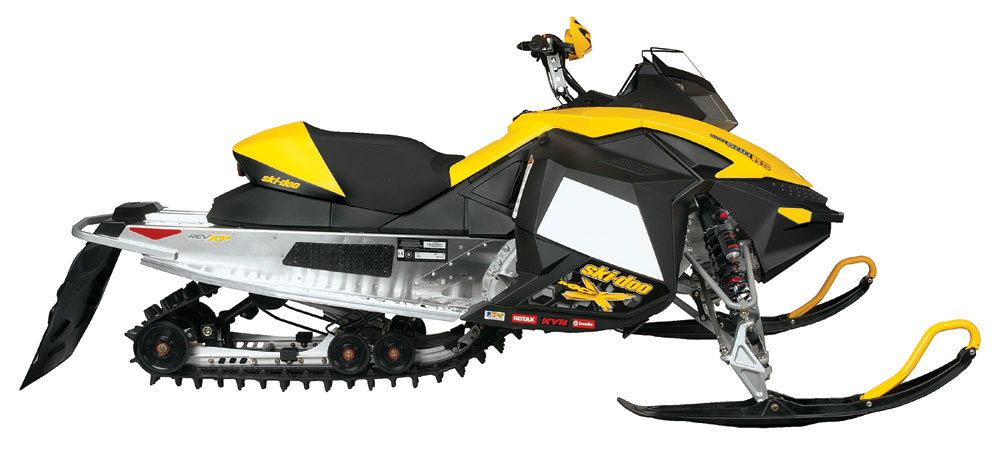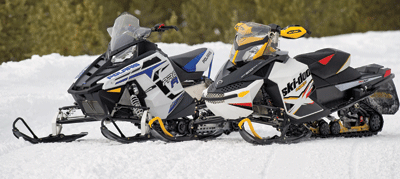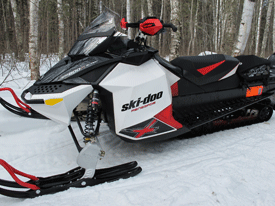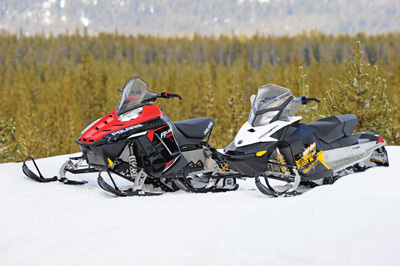First Ride: Production 2012 Ski-Doo MX Z With rMotion Suspension
 We logged just over 400 miles in on two sleds from the Snow Goer fleet last week. After spending a fair amount of time last spring on prototype 2012 MX Z models with the new rMotion rear suspension, we were eager to see how the production version shook out.
We logged just over 400 miles in on two sleds from the Snow Goer fleet last week. After spending a fair amount of time last spring on prototype 2012 MX Z models with the new rMotion rear suspension, we were eager to see how the production version shook out.
Here are impressions from our first ride on a production 2012 Ski-Doo MX Z E-TEC 600 H.O. X:
Sitting behind the bars of the MX Z felt familiar as ever. With the toe holds out front, our back upright and the handlebars a comfortable distance out front, it is a comfortable machine that’s easy to manipulate with the body’s position. The seat is firm, but comfy. Ergonomics just feel good on a REV-XP-based sled, especially for smaller riders like me (I’m 5 feet, 9 inches tall and I weigh 155 pounds).

Ride quality was quite impressive right from the get-go, especially from the new rMotion rear suspension. Many miles of trail where we rode in the Keweenaw Peninsula were chopped up with hard bumps and ruts, but that junk was mowed over quite handily by the rMotion rear suspension. It’s an impressive skidframe that isolates the rider from bumps that might otherwise sting the spine or cause a person to lose control of the sled.
The front suspension kept up quite well, but we can’t help but wonder of Ski-Doo has a new A-arm front end in the works for 2013. While handling control is top notch from the current Ski-Doo frame, bump absorption isn’t as good as the Polaris IQ front suspension or Cat’s new Arctic Race Suspension that’s bolted on 2012 ProCross and ProClimb models.
I was able to trick the E-TEC direct injection system at least a handful of times over the course of the day I rode it, causing the engine to suffer what seemed like a split-second lean hesitation. This occurred five or six times over 150 miles when I was stabbing the throttle as part of a good engine break-in procedure. (With a new engine it’s best to vary the throttle position every few seconds, and squeeze the throttle lever to full gas regularly.) I’d never felt this “hiccup” as prominently or regularly from an E-TEC direct-injected engine.
Perhaps BRP adjusted the fuel map for the break-in on 2012 sleds and this problem won’t surface again from this machine? Now that the engine has about four tanks of fuel run through it, it will be interesting to see if this strange reaction happens in the future. The engine ran well otherwise, and it became especially strong after clicking 90 miles on the odometer. A person who rode it on Day 2 of our trip said at about mile 330 that the engine had really come to life.
Fuel mileage figured after filling up with about 330 miles on the sled factored out to 12.7 miles per gallon. Thumbs vary from rider to rider, but it will be interesting to see if the mileage improves after the next tank.

This sled gave us no trouble through 400-plus miles. All it needs is for the oil tank to be topped off and track tension checked. We have 126 Woody’s studs and a set of 6-inch carbides waiting at the Snow Goer shop. We look forward to installing them and riding this fine sled with even more precise handling.
Click to also read first impressions of our Arctic Cat F 800 Sno Pro demo sled that was along for the same ride in the U.P. of Michigan.
— Andy Swanson Snow Goer Managing Editor





